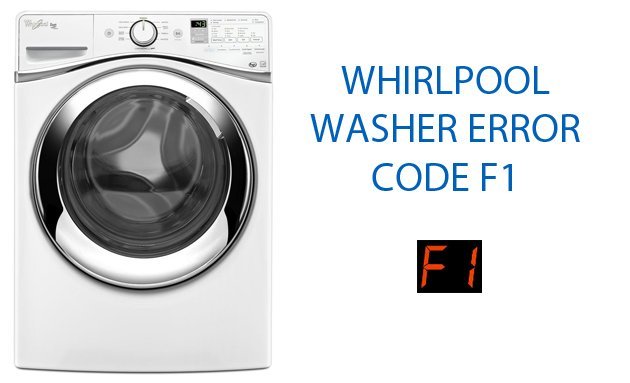
The F1 error code on Whirlpool washing machines isn’t just a random string of characters. It’s your machine’s way of trying to communicate that something isn’t right under the hood. It usually points to an issue with the control board, which is kind of like the brain of your washing machine. Ignoring it might be tempting, especially if it’s still managing to run a wash cycle. But is that really a good idea? Let’s dive in and figure out why addressing this error is important and how you can tackle it like a pro—even if you’ve never fixed a washing machine in your life.
Understanding the F1 Error Code
When your washing machine flashes the F1 error code, it’s basically waving a little red flag to get your attention. The error generally indicates a fault in the control board, but what does that even mean? Think of the control board as the conductor of an orchestra. It sends signals to various parts of your washing machine, ensuring everything performs in harmony—from filling with water to spinning those clothes squeaky clean. If the control board has a hiccup, it’s like the conductor losing his place in the sheet music. Not good, right?
This error can cause your washing machine to stop mid-cycle or even prevent it from starting in the first place. So, while it might be tempting to just keep pressing the start button until it does something, ignoring the error could lead to bigger issues down the road. Like a crack in a windshield, the problem might be small now, but it could easily grow into something much bigger—and more expensive—if left unchecked.
To figure out what’s going wrong, you’ll need to do a bit of detective work. This could involve checking for loose wires, examining the control board for visible damage, or even listening for unusual noises that might suggest something is off. But don’t worry, you don’t have to be a tech wizard to do these checks. It’s more like being a curious investigator, gathering clues and piecing them together.
Common Causes of the F1 Error Code
Now, let’s talk about why this pesky error code might appear in the first place. One common culprit is a power surge, which can be as sneaky as a squirrel raiding your bird feeder. A sudden jolt of electricity might have scrambled the control board’s circuits, leaving it confused about its primary functions. Just like how your brain feels after a surprise phone call wakes you from a deep sleep.
Another reason could be a loose connection or damaged wiring, which is similar to a light bulb flickering when its fitting is loose. Over time, vibrations from the washing machine’s normal operations can loosen screws or jostle wires, causing intermittent disruptions that lead to errors like F1. It’s like the machine is trying to communicate through Morse code, but it’s missing some dots and dashes.
Lastly, moisture or debris buildup can also cause the control board to malfunction, just like how a smudged lens can ruin a perfect photograph. If your laundry area is prone to humidity, it might be affecting the sensitive electronics inside your washing machine. Understanding these causes can help you prevent future headaches by taking some preventive actions, such as regular maintenance checks and ensuring a stable power supply.
Steps to Address the Error
Alright, let’s shift gears and talk about what you can actually do to fix this F1 error. First and foremost, safety is key. Always unplug your machine before poking around under the hood. It’s like turning off a car before checking the oil—you wouldn’t want any surprises, right?
Once you’ve ensured it’s safe, start by inspecting the control board for any obvious signs of damage. Look for burnt areas, frayed wires, or anything that seems out of place. If you’re not sure what you’re looking at, don’t worry. The idea is to spot something that stands out as abnormal, like a mismatched sock in a load of laundry.
If visually everything seems fine, consider resetting the machine. Sometimes, all it needs is a reboot, much like how restarting your computer can fix a frozen screen. Plug the machine back in and see if the error persists. If it does, it might be time to call in reinforcements—a professional technician who can dive deeper into the problem.
If you find yourself in over your head, it’s perfectly okay to seek help. Think of it like asking a friend to help assemble a tricky piece of IKEA furniture. It’s always better to have an expert eye on something complicated, ensuring nothing gets broken in the process.
Preventive Tips
Now that you know what to do when faced with this error, let’s chat about keeping it from popping up in the first place. Like a well-oiled machine, regular maintenance is key to keeping both your washing machine and your peace of mind happy.
First, try to keep your laundry area dry and dust-free. Excess moisture can short-circuit electronics, and dust can gum up works, much like a sandstorm in a delicate clock. Additionally, consider using a surge protector to shield your washing machine from power surges and fluctuations. Think of it like giving your machine an invisible umbrella to ward off unexpected electrical storms.
Regularly check your machine for any loose connections or wear and tear. Catching these early changes is like preventing a small leak from turning into a burst pipe. By doing these checks once in a while, you can save yourself a lot of hassle—or even prevent small issues from growing into bigger, pricier ones.
In the end, while it might seem like a chore to keep up with these tasks, it’s worth it. You’ll save time, money, and maybe a few panicked internet searches along the way. Remember, your washing machine is an investment, and a little love can go a long way in ensuring it serves you faithfully for years to come.